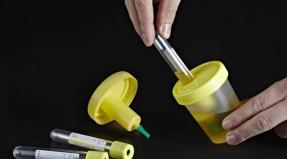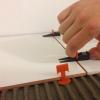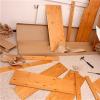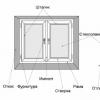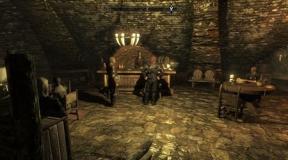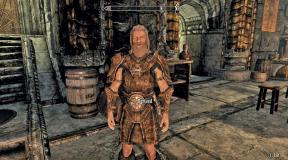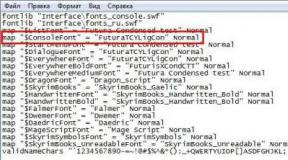Learning the addition table to 10. How to teach a child to count? Teachers advise. Memory poems for learning counting
Preparing to play - settings
- Any parameters and settings can be changed at any time, even during the game.
- Initially, the game is set up like this:
- Calculation type - Add up to 10
- Prize 1- chocolate bar, prize 2- biscuits
- In a game session 10 calculations (arithmetic examples)
- Percentage of examples that need to be solved correctly to receive the Prize 1 - 90%
- Percentage of examples that need to be solved correctly to receive the Prize 2 - 70%
- You can choose any other type of calculation, depending on what the child knows and what is going on in school at the moment. Types of calculations in the game:
- Addition, subtraction, addition and subtraction (mixed):
- To 10
- Up to 20 (with a transition through the top ten)
- Up to 20 (with a transition through the top ten and without)
- Up to 30
- Up to 100
- Multiplication, division or any combination -by 1, -by 2, -by 3 ....... etc. up to 10
- Comparing numbers
- Addition, subtraction, addition and subtraction (mixed):
- Set how many examples will be in the game session. It is better to start with a small number of attempts - 5 or 10, so as not to discourage the child from continuing to play. When the child increases milk yield :) improves performance, you can move on to a serious game with 100-200 examples.
- Enter the percentage of correctly solved examples for which 1 and 2 prizes are awarded. For a start, it's better to lower the percentage. For example, select 70 and 50 percent for 1 and 2 premiums, respectively. Later, the rates can be increased to 90 - 70. Or even up to 98% - 95% for very very smart children :). Enter only numbers, no% sign!
- Write down the prizes the child will receive for 1st and 2nd place.
- The settings will be saved using a cookie (a small script) and restored the next time you open the game page in your browser.
Now you can start the game!
- To start the game, press the START button
- When the example appears on the screen, the child must enter the answer after the "=" sign
- If we play "comparisons", you need to enter the appropriate sign:. To do this, it is most convenient to use the buttons that appear next to the NEXT button
- After the result is entered, you need to click on the OK button (or ENTER on the keyboard) to check if the example was solved correctly.
- If the example was solved correctly, "Correct" appears on the screen. If not, "Wrong" and the correct answer. At the same time, the game will calculate the percentage of correctly solved examples.
- Press the NEXT button to go to the next example.
- When the session is over, the screen will display the prize that the child won (or "won nothing") and the percentage of examples solved correctly during the session
- To start a new session, click the START OVER button.
Great expectations:)
What can you expect from this game? Great help in passing the school curriculum! As a rule, in 5-7 days, in which the child plays for 30-40 minutes, he firmly masters the next type of calculations (for example, adding up to 20 with a transition through ten). And he practically stops making mistakes in the classroom.
The very first examples that a child gets acquainted with even before school are addition and subtraction. It is not so difficult to count the animals in the picture and, crossing out the excess ones, count the remaining ones. Or shift the counting sticks and then count them. But it is a little more difficult for a child to operate with bare numbers. That is why you need practice and more practice. Do not quit studying with your child in the summer, because over the summer, the school curriculum from a small head simply wears off and it takes a long time to make up for the lost knowledge.
If your child is a first grader or is just going to first grade, start by repeating the composition of the number in houses. And now you can take on examples. In fact, addition and subtraction within ten is the first practical application by a child of knowing the composition of a number.
Click on the pictures and open the simulator at maximum magnification, then you can download the image to your computer and print it in good quality.
There is an opportunity to cut A4 in half and get 2 sheets with tasks if you want to reduce the load on the child, or give them a column per day if you decide to work out in the summer.
We solve the column, celebrate the successes: a cloud - they did not decide very well, a smiley - good, the sun - great!
Addition and subtraction within 10

Now scatter!


And with gaps (windows):

Examples for addition and subtraction within 20
By the time a child begins to study this topic of mathematics, he should know very well, by a tooth, the composition of the first ten numbers. If the child has not mastered the composition of numbers, it will be difficult for him in further calculations. Therefore, constantly return to the topic of the composition of numbers within 10, until the first grader masters it to automatism. Also, a first grader should know what the decimal (bit) composition of numbers means. In mathematics lessons, the teacher says that 10 is, in other words, 1 dozen, so the number 12 consists of 1 dozen and 2 units. When you add, the ones are added to the ones. It is on the knowledge of the decimal composition of numbers that the methods of addition and subtraction within 20 are based without going through a dozen.
Examples for printing without going through a dozen mixed up:

Addition and subtraction within 20 with the transition through a dozen are based on the techniques of adding up to 10 or subtracting up to 10, respectively, that is, on the topic "composition of the number 10", so take a responsible approach to studying this topic with your child.
Examples with a transition through a dozen (half of the sheet is addition, half is subtraction, the sheet can also be printed in A4 format and cut in half into 2 tasks):



Addition and subtraction tables are used to teach children to count or to test their skills in addition and subtraction. Different tables are used for these two tasks. Both versions of the tables can be downloaded and printed on this page
Addition table up to 20 print and download
The addition table is used for teaching children. The vertical leftmost column and the horizontal top row are addends. In order to add two numbers, you need to find them in a vertical column and in a horizontal row. The intersection forms the sum of these two terms. For example, as shown in the picture below, 6 + 5 = 11.
You can print the addition table up to 20 in Word or PDF format. If you need a table for adding up to 10, you can easily make it by deleting unnecessary cells in Word format. If you need an addition table greater than up to 20, then you can download an addition table in Excel format and add the required columns and rows by copying.
 |
|
 |
|
 |
Subtraction table up to 20 print and download
The same addition table that can be printed above is used as the subtraction table. Suppose we need to solve example 14 - 8 = 6. Using the subtraction table, we find in the table field the diagonal with the decreasing 14. In the figure below, this diagonal is highlighted in light green. Choose the number 14 on this diagonal, which is opposite the subtracted 8. The resulting number 6 in the top row is the answer.

As you can see, the same addition and subtraction table is used for addition and subtraction, which you can print or download from the links above in different formats.
Subtraction table without answers print and download

 |
Good afternoon, dear readers! How much effort adults have to make to teach a child to count between 10 and 20. And not only count, but also solve examples, subtract and add! At the same time, this is not as difficult to do as it seems at first glance. We offer you non-standard play techniques on how to teach a child to count examples within 20.
Where to begin?
Stage 2
If you have learned how to count, we get acquainted with the graphic representation of numbers. For this purpose, we use cubes with numerical images, cards.
Stage 3
The next step is very important: it prepares the foundation for quick mental arithmetic. This is the study of the composition of the number. If the baby knows exactly how numbers are decomposed, he will easily solve examples for addition and subtraction.
The study of the composition of the number is traditionally carried out using the so-called "houses". Draw a house on paper in a box. On one "floor" there are always 2 cell rooms. The number of storeys of a house is determined depending on the number of numerical pairs into which the number can be decomposed.
For example, 4 can be decomposed into 3 and 1, 2 and 2. This means that the number 4 lives in a two-story house, and so on. We will write it on the roof. The example clearly shows how to correctly make houses for the numbers 3, 4 and 5.
The child will have to memorize the resettlement of the "tenants" on the floors. Start with small numbers. Ask the baby to carefully look at who lives with which neighbor, and then "populate" the numbers on their own.
When the two and three are mastered, move on to more complex numbers. This technique gives the most solid results. Proven on my own experience.
Here you can download such a table and use it to master the methodology for the composition of a number: 
Stage 4
When the houses are passed, the turn of examples within 10 came. In the first grade, these examples will have to be solved in the first half of the year, so it is better to prepare in advance. Now all that remains is to put + or - signs between the "settlers", having previously explained their purpose to the baby.
First, present addition or subtraction in the form of a game. For example, one left the four from the floor. Which of the neighbors will stay on the floor? Answer: three. Such exercises will help the baby quickly get used to mathematical examples. Gradually, the words "left", "came" are changed to "plus" and "minus".

So we have mastered counting within 10 with the child. As you can see, the technique is very simple, but it takes time and patience to operate. Try to make the baby count in the mind first: written exercises slow down thinking.
Along the way, train the concepts of "more or less" (first use objects, expanding them on different sides, then compare the numbers), neighbors of the number (write a series of numbers with missing numbers and ask the crumbs to complete the row by placing the neighbors correctly).
Move on…
It's time to introduce the kid to the second ten. To overcome arithmetic difficulties, we propose the following training algorithm:
Part 1
We introduce the concept of ten. To do this, lay out 10 cubes in front of the child and add another one. Explaining that this is eleven. We say that the end of the word "dtsat" means "ten". To form a number from 11 to 19, all you need to do is add the number to the end of “d” and put the preposition “on” between them.

Part 2
Since the baby is already familiar with the concept of ten, we enter the category of units and, when adding, we operate with these concepts. For example, 13 + 5. First add the units: 3 + 5 = 8. Now we add the remaining ten and get 18. 
Part 3
Now let's move on to examples for minus: we act in exactly the same way. Subtract units, then add ten.
Part 4
The most difficult stage is subtraction, in which the first unit is less than the second: 13-6. In this example, we cannot subtract six from 3. You have to deal with a dozen. One of the ways is to subtract three from six, subtract the remaining number from ten, i.e. 6-3 = 3, 10-3 = 7. After a few workouts, your child will be able to do mental subtraction.

The child must clearly master the described skills: in grade 2 he will need this to solve examples with two-digit numbers.
To brighten up the learning process, you can use various aids:
- cubes;
- magnets;
- pictures (training with pictures is especially diverse: you can simply count them, use coloring pages with examples to consolidate counting skills);
- any items at hand;
- counting sticks;
- abacus, etc.
The more you show your imagination, the sooner the child will be interested in mathematics.
We have considered the sequence of learning crumbs to solve examples within 20 stages. If the article was useful to you, leave a comment or share the article with your friends in social. networks.
See you soon, dear friends!
In this lesson, you will learn how to add and subtract single digits through the digit. Solving interesting tasks, you will study the algorithm for adding and subtracting numbers with the transition through ten and get acquainted with the table for adding single-digit numbers up to 20. You will have the opportunity to practice the previously studied material with interesting examples.
Theme:Familiarity with basic concepts in mathematics
Lesson: Addition and subtraction of single-digit numbers with a transition through the digit. Addition table up to 20
The graphical model can explain addition of single-digit numbers with a transition through ten.
How can 9 and 7 be folded?(fig. 1)
Rice. 1
The graphical model shows that the first term 9 must be supplemented to 10. To do this, we divide the second term into two parts, one of which is equal to the number 1, since
9 + 1 = 10, so 7 = 1 + 6. (Fig. 2)

Rice. 2
Let's do the addition in parts:
9 + 7 = (9 + 1) + 6 = 10 + 6 = 16
Answer: 9 + 7 = 16.
You can add these numbers in a different way. (fig. 3)

Rice. 3
The second term 7 can be supplemented to 10. For this, the first term is divided into two parts, one of which is equal to 3. Therefore, 9 = 3 + 6.

Rice. 4
Let's do the addition in parts:
7 + 9 = (7 + 3) + 6 = 10 + 6 = 16
The first term is 9, it lacks up to 10 of one unit, so we break the second term into parts. 5 is 1 and 4. Add to 9 first one unit, and then the remaining four units.
9 + 5 = 9 + (1 + 4) = 14
The first term is 6, it lacks up to 10 four units, so the second term is divided into parts: 4 and 2. Add 4 to 6 first and get ten units, and then the remaining two units.
6 + 6 = 6 + (4 + 2) = 12
The first term is 4, it lacks up to 10 six, so the second term 8 is divided into parts: 6 and 2. First, add six units to 4 and get ten units, and then the remaining two units.
4 + 8 = 4 + (6 + 2) = 12
In the reduced 15 - five units, so we divide the subtracted 7 into parts: 5 and 2. Subtract five units from 15 first, we get 10. Then we subtract the remaining two units from ten.
15 - 7 = 15 - (5 + 2) = 8
In the reduced 16 - six units, so we divide the subtracted 9 into parts: 6 and 3. First subtract six units from 16, we get 10. And then subtract the remaining three units from 10.
16 - 9 = 16 - (6 + 3) = 7
In the reduced 12 - two units, so we divide the subtracted 4 into parts: 2 and 2. From 12 we subtract 2, we get 10. And from 10 we subtract 2.
12 - 4 = 12 - (2 + 2) = 8
Answer: 12 - 4 = 8.
It is not always convenient to use the technique of addition and subtraction in parts with a transition through a dozen, so you need to learn single-digit addition table up to 20 by heart.
The figure shows a table with the help of which it will be easier for you to learn the cases of adding single-digit numbers up to 20. (Fig. 7) 
Rice. 7
In each column, the first term is the same, and the second one increases by one, which means the sum will also increase by one. Let's find the value of these sums.
9 + 2 = 11, therefore: 9 + 3 = 12, reasoning like this, we fill in the entire table. (fig. 8)

Rice. eight
Each line contains the sums with the same answers. Choose the way how it will be easier for you to remember the answers: by columns or by rows. If you learn well the table of addition of single-digit numbers up to 20, then it will not be difficult for you to perform subtraction of single-digit numbers within 20.
Bibliography
- Alexandrova L.A., Mordkovich A.G. Grade 1 Mathematics. - M: Mnemosina, 2012.
- Bashmakov M.I., Nefedova M.G. Maths. 1 class. - M: Astrel, 2012.
- Bedenko M.V. Maths. 1 class. - M7: Russian Word, 2012.
- Social network of educators ().
- 5klass.net ().
- Self-taught ().
Homework
1. Remember how to correctly add and subtract single-digit numbers with a transition through the digit.
2. Help the frog solve examples.

3. Solve the examples and color the drawing.


